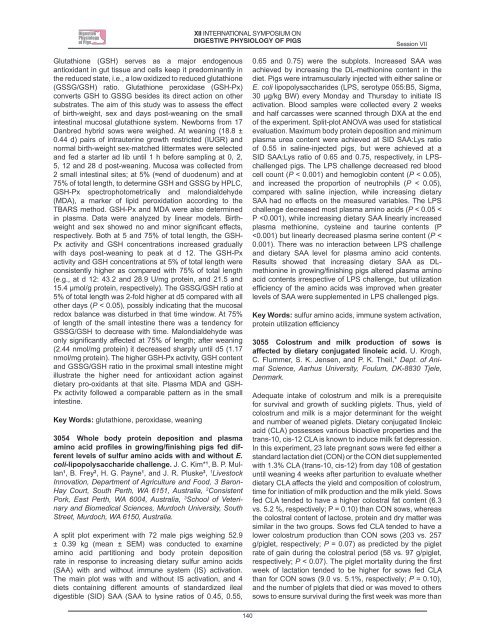XII - 12th International Symposium - Digestive Physiology of Pigs
XII - 12th International Symposium - Digestive Physiology of Pigs
XII - 12th International Symposium - Digestive Physiology of Pigs
Create successful ePaper yourself
Turn your PDF publications into a flip-book with our unique Google optimized e-Paper software.
<strong>Digestive</strong><br />
<strong>Physiology</strong><br />
<strong>of</strong> <strong>Pigs</strong><br />
Glutathione (GSH) serves as a major endogenous<br />
antioxidant in gut tissue and cells keep it predominantly in<br />
the reduced state, i.e., a low oxidized to reduced glutathione<br />
(GSSG/GSH) ratio. Glutathione peroxidase (GSH-Px)<br />
converts GSH to GSSG besides its direct action on other<br />
substrates. The aim <strong>of</strong> this study was to assess the effect<br />
<strong>of</strong> birth-weight, sex and days post-weaning on the small<br />
intestinal mucosal glutathione system. Newborns from 17<br />
Danbred hybrid sows were weighed. At weaning (18.8 ±<br />
0.44 d) pairs <strong>of</strong> intrauterine growth restricted (IUGR) and<br />
normal birth-weight sex-matched littermates were selected<br />
and fed a starter ad lib until 1 h before sampling at 0, 2,<br />
5, 12 and 28 d post-weaning. Mucosa was collected from<br />
2 small intestinal sites; at 5% (≈end <strong>of</strong> duodenum) and at<br />
75% <strong>of</strong> total length, to determine GSH and GSSG by HPLC,<br />
GSH-Px spectrophotometrically and malondialdehyde<br />
(MDA), a marker <strong>of</strong> lipid peroxidation according to the<br />
TBARS method. GSH-Px and MDA were also determined<br />
in plasma. Data were analyzed by linear models. Birthweight<br />
and sex showed no and minor significant effects,<br />
respectively. Both at 5 and 75% <strong>of</strong> total length, the GSH-<br />
Px activity and GSH concentrations increased gradually<br />
with days post-weaning to peak at d 12. The GSH-Px<br />
activity and GSH concentrations at 5% <strong>of</strong> total length were<br />
consistently higher as compared with 75% <strong>of</strong> total length<br />
(e.g., at d 12: 43.2 and 28.9 U/mg protein, and 21.5 and<br />
15.4 μmol/g protein, respectively). The GSSG/GSH ratio at<br />
5% <strong>of</strong> total length was 2-fold higher at d5 compared with all<br />
other days (P < 0.05), possibly indicating that the mucosal<br />
redox balance was disturbed in that time window. At 75%<br />
<strong>of</strong> length <strong>of</strong> the small intestine there was a tendency for<br />
GSSG/GSH to decrease with time. Malondialdehyde was<br />
only significantly affected at 75% <strong>of</strong> length; after weaning<br />
(2.44 nmol/mg protein) it decreased sharply until d5 (1.17<br />
nmol/mg protein). The higher GSH-Px activity, GSH content<br />
and GSSG/GSH ratio in the proximal small intestine might<br />
illustrate the higher need for antioxidant action against<br />
dietary pro-oxidants at that site. Plasma MDA and GSH-<br />
Px activity followed a comparable pattern as in the small<br />
intestine.<br />
Key words: glutathione, peroxidase, weaning<br />
3054 whole body protein deposition and plasma<br />
amino acid pr<strong>of</strong>iles in growing/finishing pigs fed different<br />
levels <strong>of</strong> sulfur amino acids with and without E.<br />
coli-lipopolysaccharide challenge. J. C. Kim* 1 , B. P. Mullan<br />
1 , B. Frey 2 , H. G. Payne 1 , and J. R. Pluske 3 , 1 Livestock<br />
Innovation, Department <strong>of</strong> Agriculture and Food, 3 Baron-<br />
Hay Court, South Perth, WA 6151, Australia, 2 Consistent<br />
Pork, East Perth, WA 6004, Australia, 3 School <strong>of</strong> Veterinary<br />
and Biomedical Sciences, Murdoch University, South<br />
Street, Murdoch, WA 6150, Australia.<br />
A split plot experiment with 72 male pigs weighing 52.9<br />
± 0.39 kg (mean ± SEM) was conducted to examine<br />
amino acid partitioning and body protein deposition<br />
rate in response to increasing dietary sulfur amino acids<br />
(SAA) with and without immune system (IS) activation.<br />
The main plot was with and without IS activation, and 4<br />
diets containing different amounts <strong>of</strong> standardized ileal<br />
digestible (SID) SAA (SAA to lysine ratios <strong>of</strong> 0.45, 0.55,<br />
<strong>XII</strong> INTERNATIONAL SYMPOSIUM ON<br />
DIGESTIVE PHYSIOLOGY OF PIGS<br />
140<br />
Session VII<br />
0.65 and 0.75) were the subplots. Increased SAA was<br />
achieved by increasing the DL-methionine content in the<br />
diet. <strong>Pigs</strong> were intramuscularly injected with either saline or<br />
E. coli lipopolysaccharides (LPS, serotype 055:B5, Sigma,<br />
30 μg/kg BW) every Monday and Thursday to initiate IS<br />
activation. Blood samples were collected every 2 weeks<br />
and half carcasses were scanned through DXA at the end<br />
<strong>of</strong> the experiment. Split-plot ANOVA was used for statistical<br />
evaluation. Maximum body protein deposition and minimum<br />
plasma urea content were achieved at SID SAA:Lys ratio<br />
<strong>of</strong> 0.55 in saline-injected pigs, but were achieved at a<br />
SID SAA:Lys ratio <strong>of</strong> 0.65 and 0.75, respectively, in LPSchallenged<br />
pigs. The LPS challenge decreased red blood<br />
cell count (P < 0.001) and hemoglobin content (P < 0.05),<br />
and increased the proportion <strong>of</strong> neutrophils (P < 0.05),<br />
compared with saline injection, while increasing dietary<br />
SAA had no effects on the measured variables. The LPS<br />
challenge decreased most plasma amino acids (P < 0.05 <<br />
P


